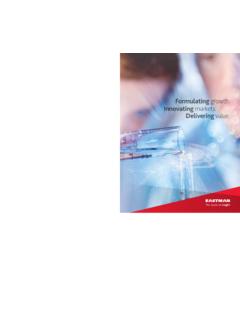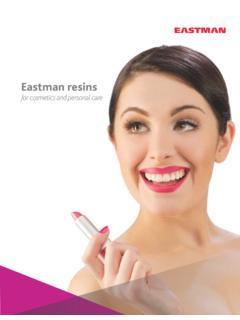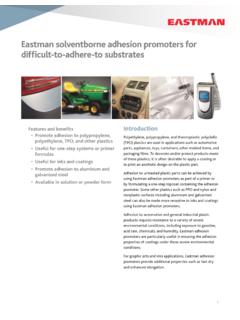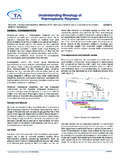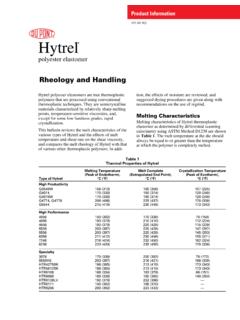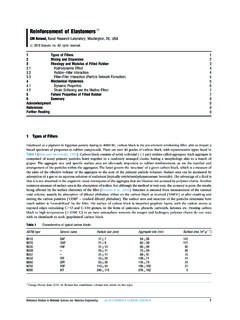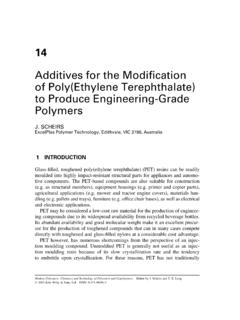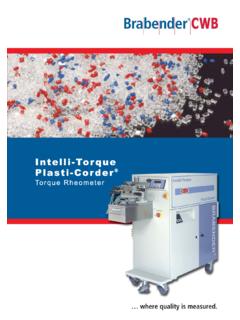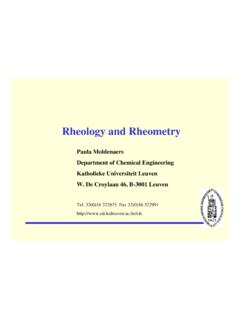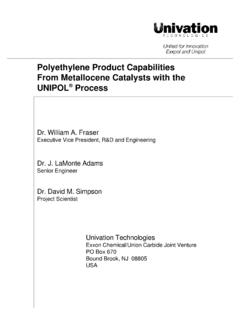Transcription of New Developments in Specialty Additives to …
1 NEW Developments IN Specialty Additives TO OPTIMIZE TPE PERFORMANCE AND PROCESSABILITYSPEAKERSJ ohnson Thomas earned his Ph. D degree in polymer Technology in 1998 from Mahatma Gandhi University, India. The focus of his research was developing novel TPE's and has gained an in depth knowledge in all aspects of polymer processing. After graduationhe has conducted advanced research at National University of Singapore and University Bordeaux in France and Center for Nanoscale Science & Engineering at North Dakota State University, Working in the polymer processing industry both in India and the , Dr. Thomas created unique solutions for generating low compression set TPE's.
2 Over all he has 14 years of research experience and his accomplishments include several peer reviewed journal articles and five patents. Currently he is a senior application scientist at Eastman Chemical Banning is the founder of Trimax. He is a mechanical engineer with 25 years of experience in plastics product design and market development for TPE's and elastomeric components. Robert Banningis also a senior member of SPE, ACS-Rubber Division and he has authored over twenty technical/marketing presentations centered on product development and trends in the thermoplastics elastomer industry. He has contributed to many plastics industry trade journals over the years, including Plastics News, Injection Molding Magazine AGENDA Introduction Market Overview/Challenges Chemistry of Eastman Performance Additives Additives for SEBS/PP Systems Morphology Mechanical Properties Elastic Properties Additives for SEBS Systems Applying Additive Benefits to TPE Applications Summary Questions & AnswersEastman Chemical A global manufacturer of chemicals, plastics and fibers 2006 sales revenue of $ Corporate headquarters in Kingsport, Tennessee USA Extensive expertise in polymers and polymer modification Coatings, Adhesives, Specialty Polymers.
3 Compounding Specialty Plastics Fibers Performance Chemicals and Intermediates Performance PolymersApplying our strong base competencies to bring value to thermoplastic elastomersTPU8%Other*7%COPE, COPA 5%TPO27%SBC 44%TPV9%Global TPE Market* New elastomer alloys and high temp TPEsEastman provides complimentary technologyto 85% of the industryBased on VolumeTraditional Tradeoffs/Challenges In SBC Based TPE Compounding Achieving targeted mechanical properties with favorable rheology Achieving lower compression set economically Improving toughness while maintaining good injection moldability Optimizing mechanical properties with favorable economicsEastman Additives help reduce these tradeoffs and challengesPerformance Additives GOALS/EFFECTS Management of TPE Rheology For injection molding For extrusion (profile/sheet)
4 For blow molding Optimization of Mechanical Properties Obtaining Required TPE Elasticity Compression set Tension set Compression stress relaxation (CSR)AGENDA Introduction Market Overview/Challenges Chemistry of Eastman Additives Additives for SEBS/PP Systems Morphology Mechanical Properties Elastic Properties Additives for SEBS Systems Applying Additive Benefits to TPE Applications Summary Questions & AnswersEastman Performance AdditivesFour Additive Families: Aromatic Additives Aliphatic Unsaturated Additives Aliphatic Saturated Additive Mixed Aromatic/AliphaticAmong each group there are variations based on feedstockorigin, molecular weight and glass transition temperatureAdditive Chemistry Aromatic resinsEndex , Kristalex , Picco , Piccolastic (Based on Styrene, Substituted Styrenes and Indenes) Aliphatic unsaturatedPiccotac 1 XXX (Based on Isoprene System) Aliphatic saturatedRegalite , Regalrez , Eastotac (Hydrogenated Resins) Mixed Aromatic/AliphaticRegalite , Piccotac , Regalrez , Eastotac (Partially Hydrogenated)
5 AGENDA Introduction Market Overview/Challenges Chemistry of Eastman Additives Additives for SEBS/PP Systems Morphology Mechanical Properties Elastic Properties Additives for SEBS Systems Applying Additive Benefits to TPE Applications Summary Questions & AnswersStudy Formulation (SEBS/PP)Formulation IngredientPHRK raton G 1651(SEBS)100 Marlex HGL 120 (Polypropylene)60 Eastman Additive10, 30 Drakeol 34 (Process Oil)200 Omycarb 3 (Calcium Carbonate)100 Irganox 1010 (Antioxidant)1 Stabilizer1 Structure/Property Relationship in TPE'sRubber/PP Ratio, Particle Size and CompatibilityTensileHardnessThermalElast ic PropElong. At BreakPP PhaseRubber Phase, Particle Size and Co-continuityMainly by PP PhaseMorphology of PP/SEBS ControlPPStyrene (S)Ethylene Butylene (EB)CONTROLSEBSE ffect of Eastman Aromatic Additiveson SEBS/PP30phr10phrAromatic Additives migrate to styrenic phase thereby increasing the over all rubber volume fraction.
6 This has a positive effect on the physical properties of the compoundEffect of Eastman Aliphatic Additiveson SEBS/PPSaturatedUnsaturatedAliphatic unsaturated resins are more compatible with styrenic phase. This changes the over all morphology of the elastomeric phase which leads to improved mechanical propertiesMechanical Properties (SEBS/PP)Tensile Strength400600800100012001400 ControlAromaticAliphaticMixedTensile Strength, Psi10phr30phrUltimate Elongation1200140016001800 ControlAromaticAliphaticMixedElongation, %10phr30phr Aromatic Additives migrate tothe elastomeric phase Aliphatic Additives arecompatible with both phases Mixed system leads to incompatibilityMechanical Properties (SEBS/PP)
7 Hardness-Shore A20406080 ControlAromaticAliphaticMixed10phr30phrT ear Strength507090110130150170 ControlAromaticAliphaticMixedTear Strength, lbf/in10phr30phr Aromatic Additives increase the volume fraction of elastomeric phase Aliphatic Additives soften the hard phaseEffect on Compression Set SEBS/PP10203040 ControlAromaticAliphaticMixedSet, %10phr30phrCompression set @ Aromatic Additives migrate to the styrenic domains and generatesa better phase separated morphology. This also increases the effective physical crosslink density in the elastomeric phase Aliphatic Additives are more compatible with elastomeric phase and effectively increases the elastomeric volume on Compression Set onSEBS/PPCompression Set @ 70 C20304050 ControlAromaticAliphaticMixedCompression Set-%10phr30phrEffect of Resin Loading on Key PropertiesSEBS/PP Aromatic Additive-Endex 160 Hardness-Shore A506070 Control5phr10phr15phr30phrAdditive LoadingHardness0 seconds15secondsTensile Strength100011001200 Control5phr10phr15phr30phrAdditive LoadingTensile Strength, PsiUltimate Elongation130014001500160017001800 Control5phr10phr15phr30phrAdditive LoadingElongation.
8 %Capillary Rheology Aromatic Additives (SEBS/PP)0500100015002000100250500100025 005000 Shear Rate, (1/s)App. Viscosity, (Poise)ControlAromatic10 phr@230 CResistance to flow would increase with increasing size and decreasing flexibility of dispersed domainsCapillary Rheology Aliphatic AdditivesSEBS/PP101000100250500100025005 000 Shear Rate, (1/S) , (Poise)ControlAliphatic05001000150020001 00250500100025005000 Shear Rate, (1/S) , (Poise)ControlAliphaticMiscibility of aliphatic Additives with PP phase decreases the Melt rheologyAGENDA Introduction Market Overview/Challenges Chemistry of Eastman Additives Additives for SEBS/PP Systems Morphology Mechanical Properties Elastic Properties Additives for SEBS Systems Applying Additive Benefits to TPE Applications Summary Questions & AnswersStudy Formulation -SEBSF ormulation IngredientPHRK raton G 1651(SEBS)100 Eastman Additive10, 30 Drakeol 34 (Process Oil)100 Omycarb 3 (Calcium Carbonate)100 Irganox 1010 (Antioxidant)
9 1 Stabilizer1 Dynamic Mechanical Analysis -SEBSA romatic + + + + + + +10-100-80-60-40-20020406080100120140160 180200 Temperature, 160-10phrControlEndex 160-30phrAliphatic + + + + + + +10-100-80-60-40-20020406080100120140160 180200 Temperature, 1126-10phrRegalrez 1126-30phr In the case of Aromatic Additives there is no shift in the Rubbery Tg Aliphatic Additives increase the Tgof the rubbery phase This suggests that Aliphatic Additives are compatible with rubber phase andaromatic Additives goes to the hard Additives in an SEBS CompoundTensile Strength2004006008001000 ControlAromaticAliphaticMixedTensile Strength, Psi10phr30 phr Aromatic Additives in pure SEBS migrate to styrene which is thehard phase Aliphatic and mixed Additives arecompatible with soft elastomericphaseUltimate Elongation12002004006008001000 ControlAromaticAliphaticMixedElongation, %10phr30 phrEastman Additives in an SEBS CompoundHardness-Shore A102030405060 ControlAromaticAliphaticMixedHardness10p hr30 phrTear Strength20406080100 ControlAromaticAliphaticMixedTear Strength.
10 Lbf/in10phr30 phr Aromatic Additives increasethe volume fraction of the hardphase which increases the tear strength and hardness Aliphatic Additives migrate tothe soft rubbery phase andtoughen the soft phaseEastman Additives in an SEBS CompoundCompression Set @ 024681012 ControlAromaticAliphaticMixed% Set10 phr30phr As the aromatic Additives increase the hard phase volume fraction, there is a loss in compression set properties at higher loading of aromatic additivesAGENDA Introduction Market Overview/Challenges Chemistry of Eastman Additives Additives for SEBS/PP Systems Morphology Mechanical Properties Elastic Properties Additives for SEBS Systems Applying Additive Benefits to TPE Applications Summary Questions & AnswersTPE Compound Selection Performance Environment Environment UV.


